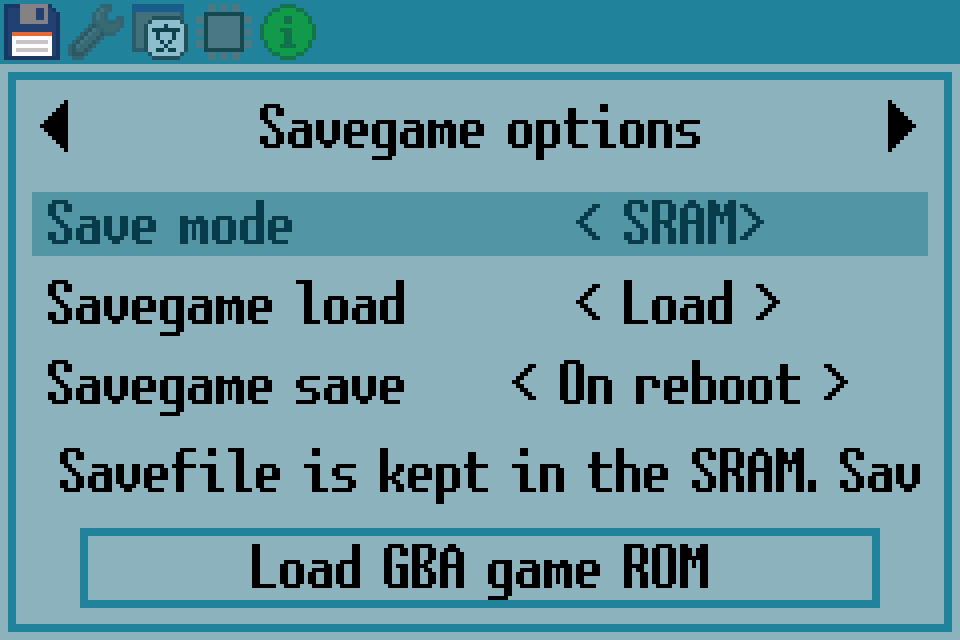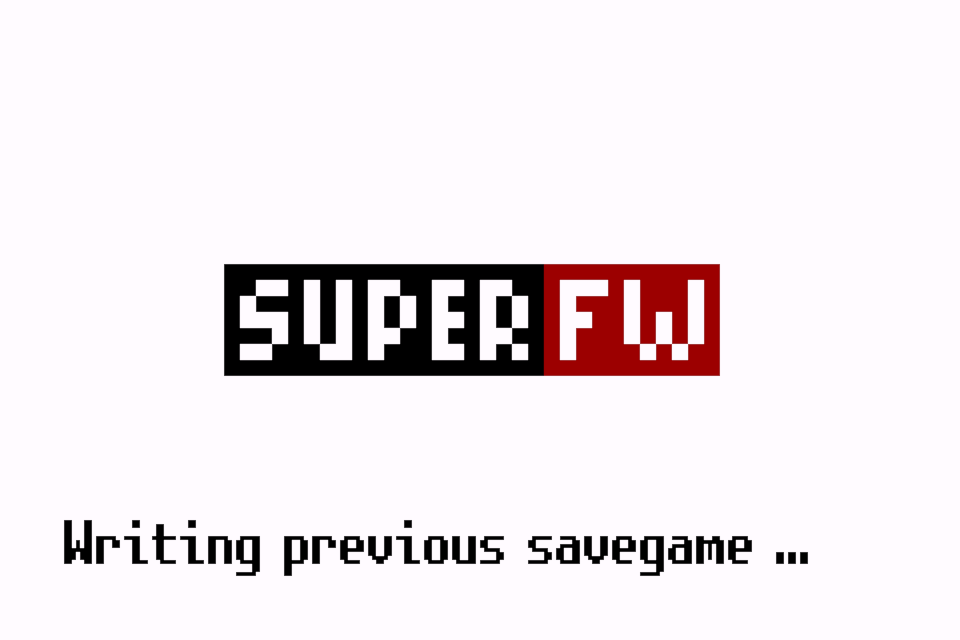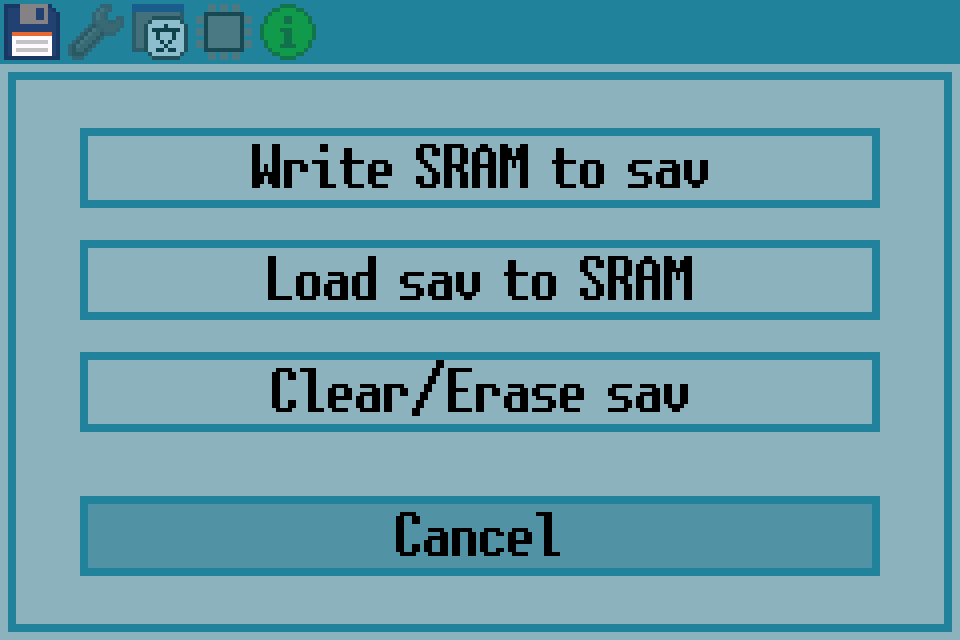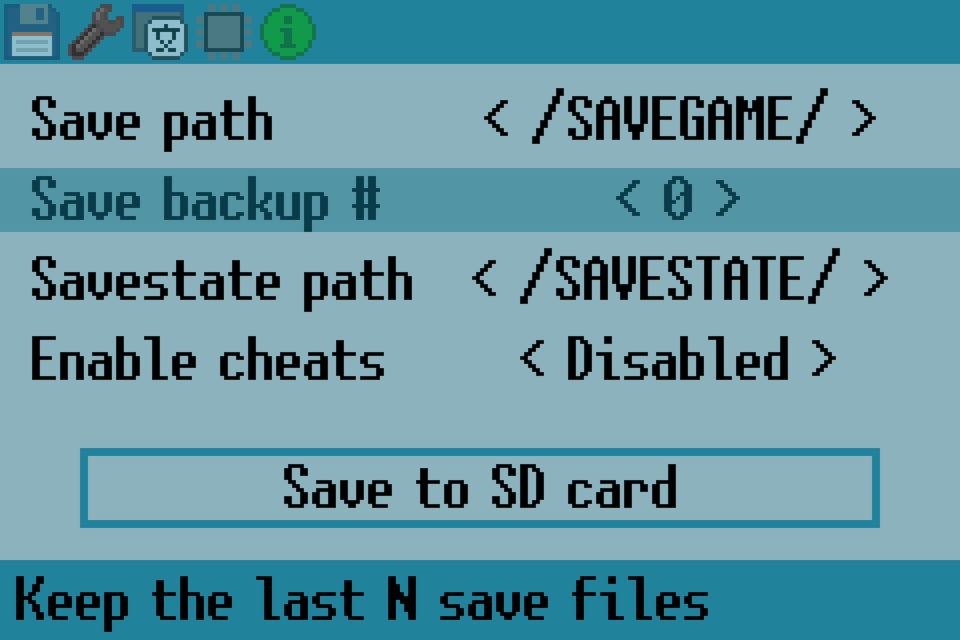Saving your game
Many GBA games allow some sort of progress saving (even though around 500 games were released without any kind of memory and might employ other techniques, such as password-based progress saving). These games use some sort of memory storage (also called cart backup in GBA jargon) to save progress data. This storage is mostly emulated in Supercard to ensure the cart can be cheaply built.
Save memory types
There are several memory types and each game will only use one. They all have different pros and cons, so game manufacturers picked them based on the game needs.
SRAM / FRAM
This saving mechanism was very popular in the GameBoy / GB Color era. The cart has an SRAM/FRAM chip that hols all the saved data. For SRAM chips, the cart requires a coin battery, since SRAM is a volatile memory type. It usually holds 32KiB of data.
Supercard is equiped with this memory type, so any games using this saving mechanism will work out of the box without any kind of patching / hacking. The downside of this memory type is that we need to write back its content into the SD card, so it can hold data for more than one ROM (ie. if you switch games by loading a different ROM).
Supercard will try to save a copy of the SRAM contents on reboot, so it is a good idea to check your battery (otherwise you might lose your data).
EEPROM
Electrically erasable programmable read-only memory (EEPROM) is a memory type that is rather slow, holds small amounts of data, but is not volatile and will hold its contents even without a battery. It comes in two sizes for most GBA games: 512 bytes or 8KiB.
Supercard doesn’t have an EEPROM, so we emulate it by patching the ROM before launching it. The patches can convert this memory type into SRAM (so they work on Supercard), or directly write the data into the SD card (so called DirectSaving mode).
Flash
Flash memory is very well known and commonly used these days. GBA games typically ship 64KiB of flash, with notable exceptions (like Pokemon) that use 128KiB. The GBA is not capable of addressing more than 64KiB, so these games use a trick called banking. This memory is slower than SRAM but can hold the data without any battery (just like a thumb drive).
Since Supercard also doesn’t have any backup flash storage, we need to emulate this using SRAM. We do this using patching.
Saving mechanisms
In general we can use patching to convert Flash/EEPROM games into SRAM. This is what the original Supercard firmware does (using its Windows patcher tool). This approach works well for most games but has a few caveats. For Flash/EEPROM games it is also possible a new mechanims called DirectSaving that was developed specifically for SuperFW. This new system doesn’t use any SRAM and reads and writes data directly to the SD card.
Using SRAM as storage
This will simply use the Supercard built-in SRAM memory as savegame storage. Any EEPROM/Flash games will be patched and converted to use this memory. There’s a few pros and cons of this approach:
- It works with most games (SRAM, Flash, EEPROM)
- Requires a reboot to write the savegame to the SD card (or using the in-game menu to save).
- Might require a working battery if saving on reboot.
This save type is only recommended for SRAM-based games. Ensure you reboot your device when you are done playing to write your progress to the SD card.


When using the In-game menu you can access the Save to SD card menu to immediately flush your SRAM to the SD card. There’s even an option to Save and quit to firmware which will just save and immediately reboot to the SuperFW menu. Should you want to not save your game (ie. you made some sort of mistake, etc.) you can use the Back to menu (skip save) option under the Reset menu. This option simply resets back to SuperFW but skips saving on reboot.

Manually handling save games
When using SRAM as saving mechanism you can manage your savegames in a completely
manual way: no automatic loading nor saving. This allows you to load a .sav
from the SuperFW menu so the next ROM you launch uses that save data. Likewise
you will be able to manually write the SRAM data after you finish playing into
any .sav file.
To use this method, ensure that you choose SRAM as save type and Manual as both load and save mechanisms. SuperFW won’t load nor store any SRAM data.

You can also choose from a bunch of possibilities. For savegame load you can specify:
- Load: It loads the
.savfile into SRAM before launching the ROM. - Clear: Will clear the SRAM, simulating a fresh new cartridge. It won’t delete
nor mangle the
.savfile. - Manual: Does nothing at all. Assumes that the SRAM contents are manually managed by the user.
For saving your savegame you can choose between:
- On reboot: Programs a file in the SD card (
.superfw/pending-save.txtto be precise) and will save the SRAM contents during the next boot. - Manual: Does nothing. You are supposed to save your SRAM data manually.
In order to load or save the SRAM contents from/to a save file, you can use the
file browsers and locate the .sav file. Pressing A on it will open the
savegame operation menu.

- Write SRAM to sav, dumps the current SRAM contents to the .sav file.
- Load sav to SRAM, performs the opposite and loads the savefile to SRAM.
- Clear/Erase sav, will overwrite the savefile with an empty save file.
Using DirectSaving
The recommended save mechanism for Flash/EEPROM games. It will directly access the SD card to read and write data. It saves your progress automatically just like with an original cart. In general it is the simplest and safest method:
- Reads and writes like a real cart.
- Doesn’t matter whether the Supercard has a working battery.
- Doesn’t require rebooting or manually saving.
- Might be slightly slower than real carts.

This mechanism is not available if the game you are playing is an SRAM-based game. You will need to use SRAM saving mechanism for these games. Also note that, since the loading/saving process is completely automated you won’t be able to use any advanced saving options like the In-game menu or any kind of manual save management.
Save game backups
Since things can go wrong sometimes (bad SD card, you drop your device, batteries run out…) and we don’t want you losing your precious save game file, SuperFW has a backup mechanism.

In the Settings menu you might specify a backup count greater than zero (setting
it to zero disables it altogether) to use this feature. SuperFW will keep a number
of savegame files as backup. For instance, when using 2 backups you might end up with
the following files: mysave.sav, mysave.1.sav, mysave.2.sav. The latest and
most recent save file is always the .sav file, and the previous copies are named
.1, .2, etc. When a new file is created, files are renamed and the oldest copy
(in this example mysave.3.sav) is deleted.